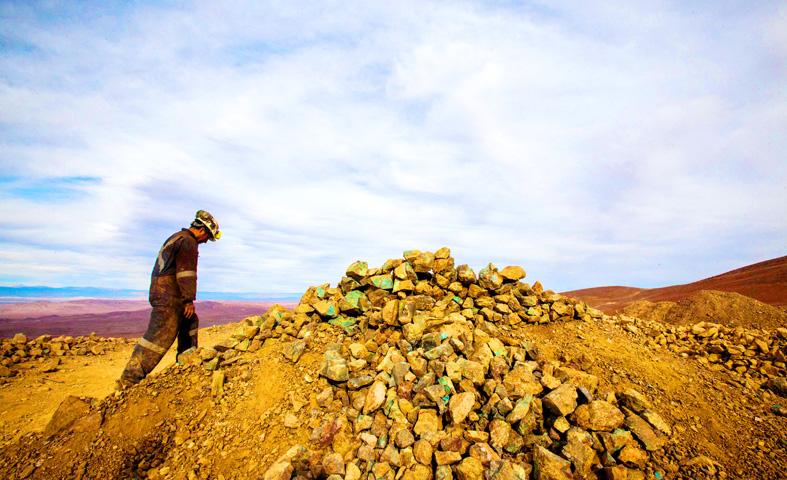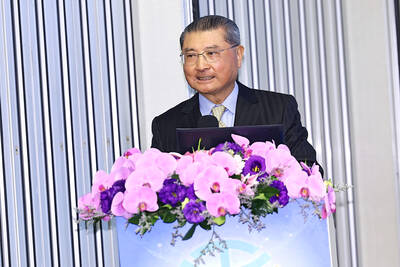Hugo Moroso individually selects rocks he extracts from the small Kiara copper mine in the Vicuna Mackenna mountain range of northern Chile, home to the largest copper deposits in the world.
Chile is the world’s top producer of copper, making up 28 percent of global output. The mineral accounts for 10 to 15 percent of the South American country’s GDP, with much of it exported to China, the world’s biggest consumer.
However, while copper prices are booming at record levels of more than US$10,000 a tonne, the same cannot be said for 70-year-old Moroso’s earnings.

Photo: AFP
“My son doesn’t want me to keep working in mining,” said Moroso, whose back-breaking labor earns him just 500,000 pesos (US$668) a month.
The Kiara mine is 130km south of Antofagasta — a paradise for copper mining giants like Australia’s BHP Billiton Ltd, which owns the Escondida site, and Chile’s state Codelco company that runs the Chuquicamata site.
Miners at those sites earn about 2 million pesos a month, well above the national average.
Antofagasta — 1,300km north of the capital, Santiago — is known as “the capital of world mining” and the source of 25 to 30 percent of Chile’s exports.
Yet poverty in the city — one of the country’s most expensive — increased from 5.1 percent in 2017 to 9.3 percent last year.
“In this city there are people that can live like in Europe and others that live in [makeshift] camps where there’s no running water, there are outhouses, dirt roads, that’s what makes you angry,” said Felipe Berrios, a priest who has lived in the Chimba area of town for six years.
Chimba lies next to a garbage dump among the city’s arid hills and is home to 1,000 families living in wooden huts. Many are immigrants from Colombia, Bolivia and Peru working menial jobs.
In this region, “which provides 10 percent of the country’s GDP, but receives only 2 percent of investment, you don’t see large roads, you don’t see the best schools, you also don’t see an improvement in hospital infrastructure,” Antofagasta governor-elect Ricardo Diaz told reporters.
Small-time miners like Moroso pick through rocks to find the ones with the most copper to sell to the Enami national mining company. Big mining companies use machines for this tiring work.
A year ago, a tonne of rocks with 2.5 percent copper content fetched 43,000 pesos; now that has soared to 109,000 pesos, but Moroso’s salary has barely budged in three decades.
“It’s the only thing I know how to do,” he told reporters.
Working conditions are tough. During the day the sun beats down in the windy desert, while at night temperatures drop dramatically.
One solace is that work is safer now than it was for the miners’ fathers.
The workers have masks and a machine to cart out the rocks they break up with pickaxes. Before, they had to lug wheelbarrows full of rocks up a slope while covering their noses with moistened socks to keep out the dust.
The copper price boom has at least created more work.
Enami has registered more than 1,400 small-scale miners and says that more than 80 operations have been reactivated since last year.
The Kiara mine reopened in August last year after three years of closure.
“It’s a good business, but you have to have the right people and look after those that work with you,” said Leonel Alvarado, one of the owners of the Kiara mine.
Changes could be afoot in Chile’s mining industry. The lower Chilean Chamber of Deputies has approved a bill pushed by left-wing parties — due to be discussed in the Chilean Senate next — that would increase taxes on the extraction of non-renewable natural resources, with the aim of investing that extra money in mining communities.
The commission that is to rewrite Chile’s dictatorship-era constitution is also planning changes to the exploitation of primary resources.
The government expects the current 40 percent sales tax — a figure similar to other major mining countries such as Australia and Peru — to increase to 70 percent.
“We agree that mining can contribute more to development in the country and in the communities where it is located, but [the bill] could have the opposite effect and make investment and production fall,” Mining Undersecretary Edgar Blanco told reporters.
However, Cristina Dorador, a scientist who represents Antofagasta on the commission rewriting the constitution, believes that “it is time to rethink these economic extraction practices.”
“People don’t understand how a region that seems so rich could be at the same time so poor and unequal, and it’s because extraction also causes inequality,” Dorador told reporters.

When an apartment comes up for rent in Germany’s big cities, hundreds of prospective tenants often queue down the street to view it, but the acute shortage of affordable housing is getting scant attention ahead of today’s snap general election. “Housing is one of the main problems for people, but nobody talks about it, nobody takes it seriously,” said Andreas Ibel, president of Build Europe, an association representing housing developers. Migration and the sluggish economy top the list of voters’ concerns, but analysts say housing policy fails to break through as returns on investment take time to register, making the

‘SILVER LINING’: Although the news caused TSMC to fall on the local market, an analyst said that as tariffs are not set to go into effect until April, there is still time for negotiations US President Donald Trump on Tuesday said that he would likely impose tariffs on semiconductor, automobile and pharmaceutical imports of about 25 percent, with an announcement coming as soon as April 2 in a move that would represent a dramatic widening of the US leader’s trade war. “I probably will tell you that on April 2, but it’ll be in the neighborhood of 25 percent,” Trump told reporters at his Mar-a-Lago club when asked about his plan for auto tariffs. Asked about similar levies on pharmaceutical drugs and semiconductors, the president said that “it’ll be 25 percent and higher, and it’ll

CHIP BOOM: Revenue for the semiconductor industry is set to reach US$1 trillion by 2032, opening up opportunities for the chip pacakging and testing company, it said ASE Technology Holding Co (日月光投控), the world’s largest provider of outsourced semiconductor assembly and test (OSAT) services, yesterday launched a new advanced manufacturing facility in Penang, Malaysia, aiming to meet growing demand for emerging technologies such as generative artificial intelligence (AI) applications. The US$300 million facility is a critical step in expanding ASE’s global footprint, offering an alternative for customers from the US, Europe, Japan, South Korea and China to assemble and test chips outside of Taiwan amid efforts to diversify supply chains. The plant, the company’s fifth in Malaysia, is part of a strategic expansion plan that would more than triple

Taiwanese artificial intelligence (AI) server makers are expected to make major investments in Texas in May after US President Donald Trump’s first 100 days in office and amid his rising tariff threats, Taiwan Electrical and Electronic Manufacturers’ Association (TEEMA, 台灣電子電機公會) chairman Richard Lee (李詩欽) said yesterday. The association led a delegation of seven AI server manufacturers to Washington, as well as the US states of California, Texas and New Mexico, to discuss land and tax issues, as Taiwanese firms speed up their production plans in the US with many of them seeing Texas as their top option for investment, Lee said. The